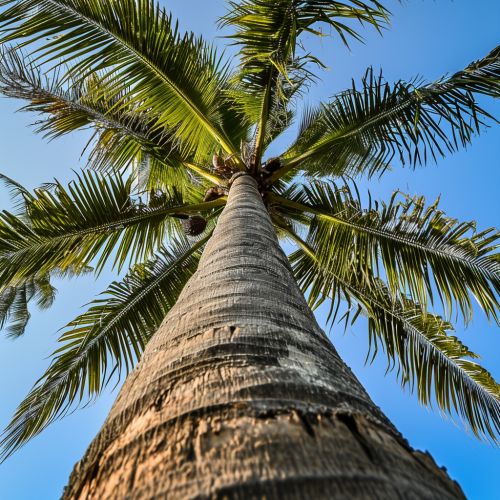Coconut
Introduction
The coconut (Cocos nucifera) is a member of the palm tree family (Arecaceae) and the only living species of the genus Cocos. The term "coconut" can refer to the whole coconut palm, the seed, or the fruit, which botanically is a drupe, not a nut. The name comes from the old Portuguese and Spanish word coco, meaning 'head' or 'skull', after the three indentations on the coconut shell that resemble facial features.


Botanical Description
Coconut palms are large, woody plants that can reach up to 30 meters in height. They have a single, slender, grey-brown trunk covered in old leaf bases. The leaves are pinnately compound, up to 6 meters long, with numerous leaflets. The inflorescence is a spadix produced at the leaf axils. The flowers are small, white, and fragrant, with three petals and sepals. The fruit is a large, oval drupe, 15–30 cm in diameter, with a hard, woody, fibrous husk surrounding the inner seed.
Distribution and Habitat
Coconut palms are native to the tropical regions of the world, particularly the Indo-Pacific region. They are found in coastal areas and on islands, often forming dense stands. They prefer sandy, well-drained soils and a high humidity environment with ample rainfall. They are highly salt-tolerant and are often found in saline coastal soils.
Cultivation and Uses
Coconut palms are grown commercially for their fruit and as ornamental plants. The fruit is used for its water, milk, oil, and meat. Coconut water is a refreshing drink, rich in electrolytes. Coconut milk and oil are used in cooking and baking, particularly in tropical and Asian cuisines. The meat of the coconut is eaten fresh or dried, and is also used in cooking and baking.
Coconut oil is also used in soaps, cosmetics, and hair oils. The husk and shells can be used for fuel and are a source of charcoal. The leaves are used for thatching, mats, and basket making. The wood of the tree is used in construction for building houses and boats.
Nutritional Value
Coconuts are a good source of several vitamins and minerals, including manganese, copper, selenium, magnesium, phosphorus, iron, and potassium. They are also high in dietary fiber and provide a significant amount of protein. Despite their high fat content, the type of fat found in coconuts is medium-chain triglycerides (MCTs), which are metabolized differently than other types of saturated fats and may have health benefits.
Health Benefits and Risks
Coconuts have been studied for their potential health benefits, including their effect on cholesterol levels, blood sugar control, and weight loss. Some studies suggest that coconuts may help reduce levels of harmful low-density lipoprotein (LDL) cholesterol and increase beneficial high-density lipoprotein (HDL) cholesterol. However, more research is needed to fully understand these effects and their implications for human health.
While coconuts are a nutritious food, they are also high in calories and fat, and should be eaten in moderation as part of a balanced diet. Some people may also be allergic to coconuts, although this is relatively rare.
Cultural Significance
Coconut palms have a long history of cultivation and use by humans, and they have significant cultural and symbolic meanings in many societies. In some cultures, they are considered sacred or have religious significance. They are also a symbol of tropical and island life.
